Seki Kanetsune
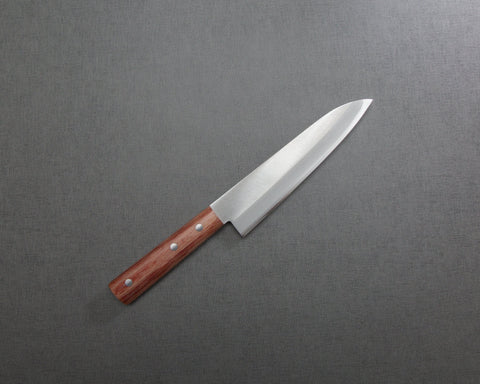
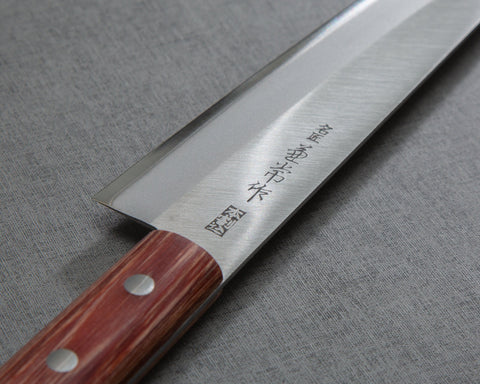
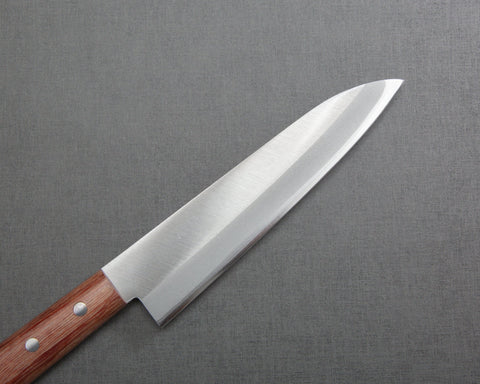
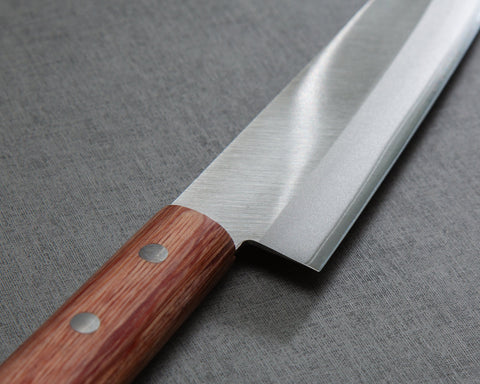
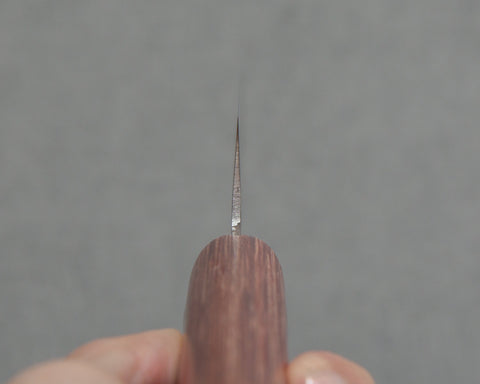
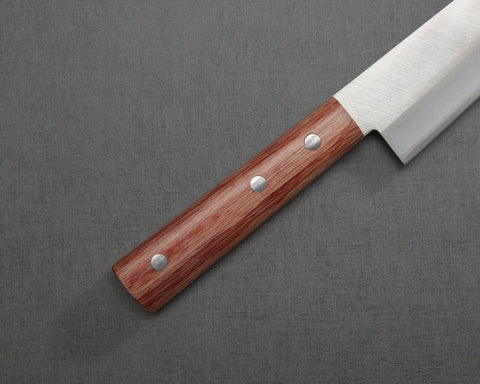
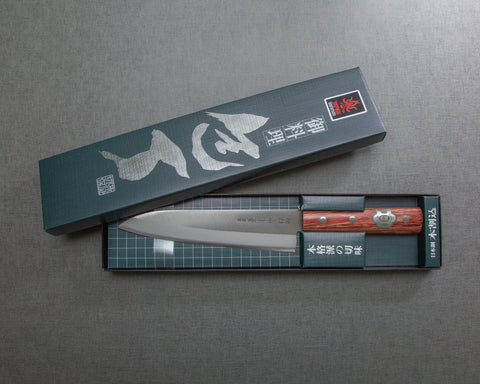
Meisho Kanetsune "KC-1000 Series" 180mm Gyuto
Pickup currently unavailable
These small gyutos from Kanetsune’s KC-1000 series are made with Takefu Shiro-2 high carbon steel core, heat-treated to 59 HRC with a stainless cladding. The blade features a Kasumi polish and is paired with a simple oval-shaped plywood handle without a bolster. The thinness behind the edge is adequate and edge retention quite excellent.
The fit and finish are pretty good consider the cost, but do expect some hairline cosmetic scratches on the blade as the handling during production is relatively rough. At this low price, this knife is a bargain for its adequate cutting performance.
Spec:
- Origin (Made in): Seki, Gifu Prefecture, Japan
- Brand: Meisho Kanetsune (part of Kanetsune Seki)
- Model No.: KC-313
- Knife Type: Gyuto
- Blade
- Construction: San Mai
- Grind: Double-edged Blade (50/50 Grind)
- Hagane (Core Steel): Takefu Shiro 2
- Jigane (Cladding): SUS410
- Hardness: 59 HRC
- Hand-sharpened
- Blade Finishes: Kasumi Polish
- Blade Length: 180mm (7.1")
- Blade Height (at heel): 43mm
- Spine Thickness
- Above heel: 1.9mm
- Middle: 1.8mm
- Handle
- Shape: Marugata (Oval-shaped)
- Material: Plywood
- Length: 121mm
- Overall Length: 305mm
- Weight: 141g (4.97oz)
- Engraved Mark: In Japanese Kanji "Craftsman Kanetsune Made Hon Warikomi" (名匠兼常作 本割込)
About Kanetsune Seki 関兼常 / Kitasho 北正
The owner of Kanetsune Seki brand — Kitasho — has been making knives in pre-war Japan, in Seki City (関市) which has over 800 years of blade-making history. After the war, they established the Kitamura Shoten, which led to the current Kitasho company. The Kanetsune (兼常) brand is named after a famous sword-smith who lived in the Muromachi period around 14-15 century. Making different series of knives under brands including Kanemasa (兼正作), Honsho Kanemasa (本匠兼正作), and Minamoto Kanemasa (源兼正), Kitasho Company is on the mission of passing down Seki’s 8 centuries long knife-making techniques and traditions.
Care:
This knife is made with Japanese high carbon steel. It is not stainless, therefore you must wipe your knife dry after each use, in particular the core steel not covered by the stainless cladding. Patina will develop over time, which will appear as “discoloration” on the cutting edge, but that is the nature of carbon steel - not a defect. The stainless cladding covers a large part of the blade, making maintenance easier but still preserving the cutting and sharpening pleasure of the carbon steel core. Avoid cutting into bones, frozen foods, hard fruit pits.
Cutting Surface:
Recommended cutting surface: wood, rubberized boards and high-end composites, and quality plastics such as polyethene make acceptable cutting surfaces, and will help protect and prolong knife’s edge. AVOID glass, metal, countertops, and other rigid, non-forgiving surfaces.
Sharpening:
We recommend sharpening all quality Japanese knives on whetstones, as we believe they yield the best results for your knives.
I wanted to test the waters of Japanese kitchen knives. As an avid collector of EDC blades this was a realm of interest yet still foreign.
Shipping - The packaging appears to be standard, yet of good quality. Though it shipped from halfway around the world it somehow arrived within 4 business days; amazing.
Finishing - The blade is well ground and finished. There is a beautiful orange peel type finish on the taper above the edge. The handle material feels good, is shaped well, and has zero hot spots. I do not understand how this is considered a "budget" blade; It is at least 5x better in quality than most everything western that I've held in stores or in friends and families kitchens(including big brands like Wusthof, Henckels, etc).
Use - It is very light and well balanced. The edge is very finely ground. I've not had to sharpen it yet, but the blade is already thin and then tapers from the spine all the way to the edge. This knife truly *cuts* material. When cutting something like a potato with a western chef's knife it feels like you're splitting it, like an axe through a log. With this knife you can feel it slicing through the material like a laser beam, its breathtaking.
Maintenance - We clean the knife after each use, though a few times my wife has left it overnight with material on it. Even with this abuse it only has the every so slightest golden patina on the edge only visible under bright light. I very much look forward to seeing how beautiful the carbon steel core looks after a year or two. I have not had to sharpen it yet, but assume like most all Japanese carbon steel knives it will be easy to apex and deburr thanks to the pureness of their steel and consistent heat treatment.
tl;dr This thing is a lightsaber, just buy it.
This knife is definitely worth the price and maybe more. So far it is holding its edge, even after cutting on some not so nice surfaces, and one of the better knives I have bought recently at this price. I am definitely enjoying and look forward continuing to see how well it will hold up especially after one of my previous knives I purchased from here, the handle busted after some usage.
I couldn't have asked for a better knife... unless I were to pay more than double the price. This is a steal! Loved it since the first moment I had it in my hands. It is on the smaller side, but it's just the right size for me cause I have small hands and don't like big knives. Perfect balance, light, and really sharp. The pictures in the listing are exactly what you get; no need to add more.
Free Shipping
Free Shipping on most orders.
30 Days Return
Return unused within 30 days for a full refund, no questions asked (terms apply).
Top Japanese Makers
All knives made in Japan by top Japanese knife makers.
About
Burrfection Store sources professionally designed sharpening products, and knives from top Japanese craftsmen.
